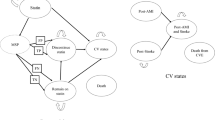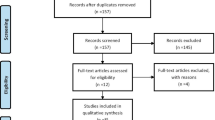Abstract
Purpose
To aid prescribers in assessing a patient’s risk for statin-induced myopathy (SIM), we performed a comprehensive review of currently known risk factors and calculated aggregated odds ratios for each risk factor through a meta-analysis.
Methods
This meta-analysis was done through four phases: (1) Identification of the relevant primary literature; (2) abstract screening using inclusion and exclusion criteria; (3) detailed review and data extraction; and (4) synthesis and statistical analysis.
Results
Out of 44 papers analyzed from 836 papers searched from MEDLINE, 18 different potential risk factors were collected, divided into three categories: three demographics (11 papers), ten clinical factors (31 papers), and five pharmacogenetics/biomarkers (12 papers). Risk factors significant for myopathy and/or rhabdomyolysis included age, gender, diabetes, renal impairment, cardiovascular disease, certain interacting drugs, and mutations of the SLCO1B1 gene, which encodes a transporter protein in the liver. Several factors, such as gender, race, cardiovascular disease, and the GATM gene, which encodes a protein for creatine synthesis, appeared to be protective in terms of the outcomes of interest.
Conclusions
This comprehensive assessment of risk factors can help support clinicians in reducing the incidence of SIM in their patient population on statins.

Similar content being viewed by others
References
Schwartz GG, Olsson AG, Ezekowitz MD, Ganz P, Oliver MF, Waters D, Zeiher A, Chaitman BR, Leslie S, Stern T, Myocardial Ischemia Reduction with Aggressive Cholesterol Lowering (MIRACL) Study Investigators (2001) Effects of atorvastatin on early recurrent ischemic events in acute coronary syndromes the MIRACL study: a randomized controlled trial. JAMA 285:1711–1718
Pasternak RC, Smith SC, Bairey-Merz CN et al (2002) ACC/AHA/NHLBI clinical advisory on the use and safety of statins. J Am Coll Cardiol 40:567–572
Heart Protection Study Collaborative Group (2002) MRC/BHF Heart protection study of cholesterol lowering with simvastatin in 20,536 high-risk individuals: a randomised placebo-controlled trial. Lancet 360:7–22. https://doi.org/10.1016/S0140-6736(02)09327-3
Conroy RM, Pyörälä K, Fitzgerald AP, Sans S, Menotti A, de Backer G, de Bacquer D, Ducimetière P, Jousilahti P, Keil U, Njølstad I, Oganov RG, Thomsen T, Tunstall-Pedoe H, Tverdal A, Wedel H, Whincup P, Wilhelmsen L, Graham IM, SCORE project group (2003) Estimation of ten-year risk of fatal cardiovascular disease in Europe: the SCORE project. Eur Heart J 24:987–1003. https://doi.org/10.1016/S0195-668X(03)00114-3
Mills EJ, Rachlis B, Wu P, Devereaux PJ, Arora P, Perri D (2008) Primary prevention of cardiovascular mortality and events with statin treatments: a network meta-analysis involving more than 65,000 patients. J Am Coll Cardiol 52:1769–1781. https://doi.org/10.1016/j.jacc.2008.08.039
Spence JD, Dresser GK (2016) Overcoming challenges with statin therapy. J Am Heart Assoc 5:1–13. https://doi.org/10.1161/JAHA.115.002497
Chatzizisis YS, Koskinas KC, Misirli G, Vaklavas C, Hatzitolios A, Giannoglou GD (2010) Risk factors and drug interactions predisposing to statin-induced myopathy: implications for risk assessment, prevention and treatment. Drug Saf 33:171–187. https://doi.org/10.2165/11319380-000000000-00000
Gu Q, Paulose-Ram R, Burt VL, Kit BK (2014) Prescription cholesterol-lowering medication use in adults aged 40 and over: United States, 2003–2012. NCHS data brief, no 177. National Center for Health Statistics, Hyattsville
Stone NJ, Robinson JG, Lichtenstein AH, Bairey Merz CN, Blum CB, Eckel RH, Goldberg AC, Gordon D, Levy D, Lloyd-Jones DM, McBride P, Schwartz JS, Shero ST, Smith SC Jr, Watson K, Wilson PW, Eddleman KM, Jarrett NM, LaBresh K, Nevo L, Wnek J, Anderson JL, Halperin JL, Albert NM, Bozkurt B, Brindis RG, Curtis LH, DeMets D, Hochman JS, Kovacs RJ, Ohman EM, Pressler SJ, Sellke FW, Shen WK, Smith SC Jr, Tomaselli GF, American College of Cardiology/American Heart Association Task Force on Practice Guidelines (2014) 2013 ACC/AHA guideline on the treatment of blood cholesterol to reduce atherosclerotic cardiovascular risk in adults: a report of the american college of cardiology/american heart association task force on practice guidelines. Circulation 129:85–S45. https://doi.org/10.1161/01.cir.0000437738.63853.7a
Martin SS, Abd TT, Jones SR, Michos ED, Blumenthal RS, Blaha MJ (2014) 2013 ACC/AHA cholesterol treatment guideline: what was done well and what could be done better. J Am Coll Cardiol 63:2674–2678. https://doi.org/10.1016/j.jacc.2014.02.578
Alfirevic A, Neely D, Armitage J, Chinoy H, Cooper RG, Laaksonen R, Carr DF, Bloch KM, Fahy J, Hanson A, Yue QY, Wadelius M, Maitland-van der Zee AH, Voora D, Psaty BM, Palmer CNA, Pirmohamed M (2014) Phenotype standardization for statin-induced myotoxicity. Clin Pharmacol Ther 96:470–476. https://doi.org/10.1038/clpt.2014.121
Rosenson RS, Baker SK, Jacobson TA, et al. An assessment by the statin muscle safety task force: 2014 update. J Clin Lipidol 8:S58–71. https://doi.org/10.1016/jjacl201403.004
Kamal-Bahl SJ, Burke T, Watson D, Wentworth C (2007) Discontinuation of lipid modifying drugs among commercially insured United States patients in recent clinical practice. Am J Cardiol 99:530–534. https://doi.org/10.1016/j.amjcard.2006.08.063
Lardizabal JA, Deedwania PC (2010) Benefits of statin therapy and compliance in high risk cardiovascular patients. Vasc Health Risk Manag 6:843–853. https://doi.org/10.2147/VHRM.S9474
Thompson PD, Clarkson P, Karas RH (2003) Statin-associated myopathy. JAMA 289:1681.1690
Bays H (2006) Statin safety: an overview and assessment of the data—2005. Am J Cardiol 97:6C–26C. https://doi.org/10.1016/j.amjcard.2005.12.006
Patel J, Superko HR, Martin SS, Blumenthal RS, Christopher-Stine L (2015) Genetic and immunologic susceptibility to statin-related myopathy. Atherosclerosis 240:260–271. https://doi.org/10.1016/j.atherosclerosis.2015.03.025
Bruckert E, Hayem G, Dejager S, Yau C, Bégaud B (2005) Mild to moderate muscular symptoms with high-dosage statin therapy in hyperlipidemic patients—the PRIMO study. Cardiovasc Drugs Ther 19:403–414. https://doi.org/10.1007/s10557-005-5686-z
Law M, Rudnicka AR (2006) Statin safety: a systematic review. Am J Cardiol 97:S52–S60. https://doi.org/10.1016/j.amjcard.2005.12.010
Davidson MH, Clark JA, Glass LM, Kanumalla A (2006) Statin safety: an appraisal from the adverse event reporting system. Am J Cardiol 97:32C–43C. https://doi.org/10.1016/j.amjcard.2005.12.008
Gamboa CM, Safford MM, Levitan EB, Mann DM, Yun H, Glasser SP, Woolley JM, Robert R, Farkouh M, Muntner P (2014) Statin underuse and low prevalence of LDL-C control among U.S. adults at high risk of coronary heart disease. Am J Med Sci 348:108–114. https://doi.org/10.1097/MAJ.0000000000000292
Fernandez G, Spatz ES, Jablecki C, Phillips PS (2011) Statin myopathy: a common dilemma not reflected in clinical trials. Cleve Clin J Med 78:393–403. https://doi.org/10.3949/ccjm.78a.10073
Martin RL (2004) Effectiveness of statin titration on low-density lipoprotein cholesterol goal attainment in patients at high risk of atherogenic events. Am J Cardiol 93:525. https://doi.org/10.1016/j.amjcard.2003.09.063
O’Meara JG, Kardia SLR, Armon JJ et al (2004) Ethnic and sex differences in the prevalence, treatment, and control of dyslipidemia among hypertensive adults in the GENOA study. Arch Intern Med 164:1313–1318. https://doi.org/10.1001/archinte.164.12.1313
Gupta A, Thompson PD (2011) The relationship of vitamin D deficiency to statin myopathy. Atherosclerosis 215:23–29. https://doi.org/10.1016/j.atherosclerosis.2010.11.039
Wilke RA, Ramsey LB, Johnson SG, Maxwell WD, McLeod H, Voora D, Krauss RM, Roden DM, Feng Q, Cooper-Dehoff RM, Gong L, Klein TE, Wadelius M, Niemi M, Clinical Pharmacogenomics Implementation Consortium (CPIC) (2012) The clinical pharmacogenomics implementation consortium: CPIC guideline for SLCO1B1 and simvastatin-induced myopathy. Clin Pharmacol Ther 92:112–117. https://doi.org/10.1038/clpt.2012.57
Hou Q, Li S, Li L, Li Y, Sun X, Tian H (2015) Association between SLCO1B1 gene T521C polymorphism and statin-related myopathy risk: a meta-analysis of case-control studies. Medicine (Baltimore) 94:e1268. https://doi.org/10.1097/MD.0000000000001268
Vrablik M, Zlatohlavek L, Stulc T et al (2014) Statin-associated myopathy: from genetic predisposition to clinical management. Physiol Res 63(Suppl 3):S327–S334
Cohen JD, Brinton EA, Ito MK, Jacobson TA (2012) Understanding statin use in America and gaps in patient education (USAGE): an internet-based survey of 10,138 current and former statin users. J Clin Lipidol 6:208–215. https://doi.org/10.1016/j.jacl.2012.03.003
Rosenbaum D, Dallongeville J, Sabouret P, Bruckert E (2013) Discontinuation of statin therapy due to muscular side effects: a survey in real life. Nutr Metab Cardiovasc Dis 23:871–875. https://doi.org/10.1016/j.numecd.2012.04.012
McClure DL, Valuck RJ, Glanz M, Hokanson JE (2007) Systematic review and meta-analysis of clinically relevant adverse events from HMG CoA reductase inhibitor trials worldwide from 1982 to present. Pharmacoepidemiol Drug Saf 16:132–143. https://doi.org/10.1002/pds
Baigent C, Keech A, Kearney P et al (2005) Efficacy and safety of cholesterol-lowering treatment: prospective meta-analysis of data from 90,056 participants in 14 randomised trials of statins. Lancet 366:1267–1278. https://doi.org/10.1016/S0140-6736(05)67394-1
Hennessy S, Leonard C, Gagne JJ, Flory JH, Han X, Brensinger CM, Bilker WB (2016) Pharmacoepidemiologic methods for studying the health effects of drug-drug interactions. Clin Pharmacol Ther 99:92–100. https://doi.org/10.1002/cpt.277
Lubin JHH, Gail MHH (1984) Biased selection of controls for case-control analyses of cohort studies. Biometrics 40:63–75
Luzum JA, Kitzmiller JP, Isackson PJ, Ma C, Medina MW, Dauki AM, Mikulik EB, Ochs-Balcom HM, Vladutiu GD (2015) GATM polymorphism associated with the risk for statin-induced myopathy does not replicate in case-control analysis of 715 dyslipidemic individuals. Cell Metab 21:622–627. https://doi.org/10.1016/j.cmet.2015.03.003
Mangravite LM, Engelhardt BE, Medina MW, Smith JD, Brown CD, Chasman DI, Mecham BH, Howie B, Shim H, Naidoo D, Feng QP, Rieder MJ, Chen YDI, Rotter JI, Ridker PM, Hopewell JC, Parish S, Armitage J, Collins R, Wilke RA, Nickerson DA, Stephens M, Krauss RM (2013) A statin-dependent QTL for GATM expression is associated with statin-induced myopathy. Nature 502:377–380. https://doi.org/10.1038/nature12508
Palamaner Subash Shantha G, Ramos J, Thomas-Hemak L, Pancholy SB (2014) Association of vitamin D and incident statin induced myalgia—a retrospective cohort study. PLoS One 9:e88877. https://doi.org/10.1371/journal.pone.0088877
Isackson PJ, Ochs-Balcom HM, Ma C, Al E (2011) Association of common variants in the human eyes shut ortholog, EYS, with statin-induced myopathy: evidence for additional functions of EYS. Muscle Nerve 44:531–538. https://doi.org/10.3851/IMP2701.Changes
Iwere RB, Hewitt J (2015) Myopathy in older people receiving statin therapy: a systematic review and meta-analysis. Br J Clin Pharmacol 80:363–371. https://doi.org/10.1111/bcp.12687
Romaine SPR, Bailey KM, Hall AS, Balmforth AJ (2010) The influence of SLCO1B1 (OATP1B1) gene polymorphisms on response to statin therapy. Pharmacogenomics J 10:1–11. https://doi.org/10.1038/tpj.2009.54
Su J, Xu H, Yang J, Yu Q, Yang S, Zhang J, Yao Q, Zhu Y, Luo Y, Ji L, Zheng Y, Yu J (2015) ABCB1 C3435T polymorphism and the lipid-lowering response in hypercholesterolemic patients on statins: a meta-analysis. Lipids Health Dis 14:122. https://doi.org/10.1186/s12944-015-0114-2
Ghatak A, Faheem O, Thompson PD (2010) The genetics of statin-induced myopathy. Atherosclerosis 210:337–343. https://doi.org/10.1016/j.atherosclerosis.2009.11.033
Ramsey LB, Johnson SG, Caudle KE, Haidar CE, Voora D, Wilke RA, Maxwell WD, McLeod HL, Krauss RM, Roden DM, Feng Q, Cooper-DeHoff RM, Gong L, Klein TE, Wadelius M, Niemi M (2014) The clinical pharmacogenetics implementation consortium guideline for SLCO1B1 and simvastatin-induced myopathy: 2014 update suppl material. Clin Pharmacol Ther 96:1–6. https://doi.org/10.1038/clpt.2014.125
Acknowledgements
This work was made possible by the support of Clem MacDonald chair account and by Lilly Endowment Inc. Physician Scientist Initiative. We gratefully acknowledge Lane Coffee’s help with manuscript preparation, and Sandy Poremba’s and Lisa Gill’s in preparing the bibliography.
Funding
This work was further supported by VA HSR&D grant CIN 13-416 at the Richard L. Roudebush Veterans Affairs Medical Center in Indianapolis, Indiana.
Author information
Authors and Affiliations
Corresponding author
Ethics declarations
Conflict of interest
The authors declare that they have no conflicts of interest.
Electronic supplementary material
ESM 1
(DOCX 1001 kb)
Rights and permissions
About this article
Cite this article
Nguyen, K.A., Li, L., Lu, D. et al. A comprehensive review and meta-analysis of risk factors for statin-induced myopathy. Eur J Clin Pharmacol 74, 1099–1109 (2018). https://doi.org/10.1007/s00228-018-2482-9
Received:
Accepted:
Published:
Issue Date:
DOI: https://doi.org/10.1007/s00228-018-2482-9




